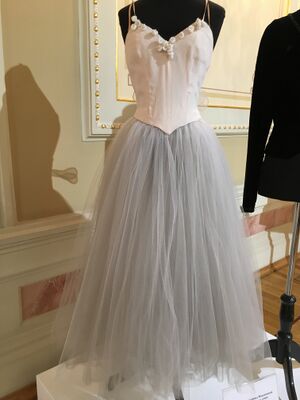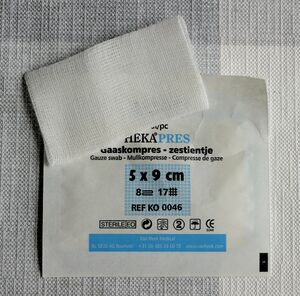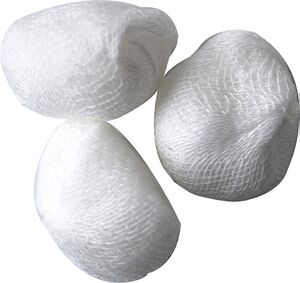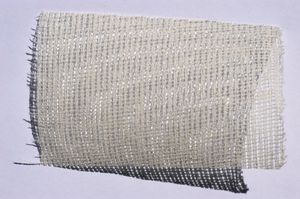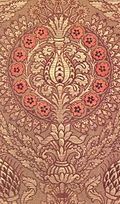شاش
الشاش Gauze قماشٌ رقيقٌ كثير الثقوب مصنوعٌ من القطن أو الحرير، أو الرايون، أو الخيوط الصناعية. صُنع هذا القماش لأول مرة في مدينة غزة بفلسطين ولذلك فاسمه بالإنجليزية Gauze مشتق من اسم المدينة. تُنسج الخيوط بطريقة خاصة تُدعى لينو أو النسيج الشاشي. في حالة اللينو، تكون خيوط السداة (ما مُد من خيوط النسيج طوُلاً) مزدوجة دائما. تُلف خيوط الطول المزدوجة بعضها ببعض كلما مرت بخيوط اللُّحمة (ما نُسج عرضا من الخيوط). وفي هذه الحالة، تكون الخيوط قد أُبقيت متباعدة على مسافة ثابتة، مع تماسكها. يستخدم نسيج لينو في صناعة الناموسيات، والمركزيتات (أنسجة رقيقة مشبّكة)، وقماش المنخل الذي ينخل الدقيق في الطواحين. كما أن شاش العمليات الجراحية أو المستشفيات هو من نوع قماش الجبن (قماش رقيق استعمل أصلاً للف الجبن) في نسيج بسيط. كما أن اسم الشاش يُستخدم للدلالة على أقمشة الستائر الشفافة.
Gauze can also be made of non-woven fabric.[1]
أصل الكلمة الغربية والتاريخ
The word came into English via French gaze, beyond which its history is uncertain.[2] The 1279 Council of Baden banned clergy from wearing "black burnet, garzatum, and all other fine cloths",[3] and the term garças is known in Italian texts from ح. 1250.[4][5] Du Cange suggested connecting it to the place name Gaza (العربية: غزة ghazza),[6] but it is more likely to derive from Persian gazi, a thin cloth,[7] or العربية: قز qaz, raw silk.[8]
الاستخدامات والأنواع
Gauze was originally made of silk and was used for clothing. It is now used for many different things, including gauze sponges for medical purposes. Modern gauze is also made of synthetic fibers, especially when used in clothing.
المنسوج وغير المنسوج
Gauze may be woven or non-woven. Woven gauze is loosely woven, usually from cotton fibers, allowing absorption or wicking of exudate and other fluids. Gauze can be woven with fine or coarse mesh; coarse gauze is useful for medical debridement, while fine gauze is better for packing wounds. Woven gauze is less absorbent than non-woven, and may leave lint in a wound, especially if cut.[9]
Non-woven gauze is made from fibers that are pressed together rather than woven, providing better absorbency and wicking than woven gauze. Non-woven gauze is usually made from synthetic fibers such as rayon or polyester, or a blend which may include cotton. Non-woven gauze is stronger, bulkier and softer than woven gauze, and produces less lint.[9]
الاستخدام الطبي
When used as a medical dressing, woven gauze is usually made of cotton. It is especially useful for dressing wounds where other fabrics might stick to the burn or laceration. Many modern medical gauzes are covered with a perforated plastic film such as Telfa or a polyblend which prevents direct contact and further minimizes wound adhesion. Also, it can be impregnated with a thick, creamy mixture of zinc oxide and calamine to promote healing, as in Unna's boot. Gauze is also used during procedures involving accidental tooth loss; either the gauze is used to provide pressure as the tooth is moved back into its corresponding socket, or the tooth is wrapped in gauze and placed in milk or saline to keep it alive while the tooth is being transported or prepared for reinsertion.[10]
استخدامات أخرى
In film and theatre, gauze is often fashioned into a scrim.
Gauze used in bookbinding is called mull, and is used in case binding to adhere the text block to the book cover.[11]
The term wire gauze is used for woven metal sheets, for example placed on top of a Bunsen burner, or used in a safety lamp or a screen spark arrestor.
انظر أيضاً
- Wire netting
- Mesh
- Band-Aid (Johnson & Johnson brand product)
- ضمادة لاصقة
الهامش
- ^ "Wound management - Woven and fabric swabs/Non-woven Fabric Swab (BNF content)". The National Institute for Health and Care Excellence. Retrieved 5 December 2021.
- ^ "GAZE : Etymologie de GAZE". www.cnrtl.fr. Retrieved 2024-01-30.
- ^ Leges Ecclesiasticae Regni Hungariae Et Provinciarum Adiacentium (in اللاتينية). Typis Episcopalibus. 1827.
- ^ Battisti, Carlo; Alessio, Giovanni (1952). Dizionario etimologico italiano: Fa - Me (in الإيطالية). Florence: Barbèra. p. 1767.
- ^ Frati, Luigi (1869). Statuti di Bologna: Dall' anno 1245 all' anno 1267 (in اللاتينية). Regia Tipografia.
- ^ Cange (sieur), Charles Du Fresne Du (1733). Glossarium ad scriptores mediae et infimae latinitatis (in اللاتينية). sub oliva C. Osmont, via Dan-Jacobaea.
- ^ Gilman, Daniel Coit; Peck, Harry Thurston; Colby, Frank Moore (1903). The New International Encyclopædia (in الإنجليزية). Dodd, Mead and Company.
- ^ Cannon, Garland Hampton; Kaye, Alan S. (1994). The Arabic Contributions to the English Language: An Historical Dictionary (in الإنجليزية). Otto Harrassowitz Verlag. ISBN 978-3-447-03491-3.
- ^ أ ب Serebrennik, Mikhail (20 September 2016). "What is the difference between woven and non-woven gauze?". Lighthouse Medical Supplies.
- ^ Belladonna, Felipe G.; Poly, Ane; Teixeira, João M. S.; Nascimento, Viviane D. M. A.; Fidel, Sandra R.; Fidel, Rivail A. S. (2012). "Avulsion of permanent teeth with open apex: a systematic review of the literature". RBSO. 9 (3). ISSN 1984-5685.
- ^ Cambras, Josep (2004). The complete book of bookbinding. Lark Books. p. 48. ISBN 978-1-57990-646-7.
ببليوجرافيا
- Garrison, Webb B. (2008), Why You Say It, READ BOOKS, ISBN 144373182X, 9781443731829, http://books.google.ca/books?id=iFZi9EXyXrwC&pg=PA261&dq=gauze++etymology++persian&lr=&as_brr=3
- McCarthy, Michael; O'Dell, Felicity; Shaw, Ellen (1997), Vocabulary in use: upper intermediate : reference and practice for students of North American English (Illustrated ed.), Cambridge University Press, ISBN 0521577683, 9780521577687, http://books.google.ca/books?id=P7OxIBV7VDQC&pg=PA30&dq=gauze+gaza&lr=&as_brr=3
- Skeat, Walter W. (1993), The concise dictionary of English etymology (Reprint ed.), Wordsworth Editions, ISBN 1853263117, 9781853263118, http://books.google.ca/books?id=aDhGlKL3h00C&pg=PA172&dq=gauze++etymology&lr=&as_brr=3
- Taylor, Isaac (2005), Words and Places Or Etymological Illustrations of History, Ethnology and Geography, Kessinger Publishing, ISBN 1417971576, 9781417971572, http://books.google.ca/books?id=x-4rutCY2csC&pg=PA288&dq=gauze++etymology+spanish&lr=&as_brr=3

